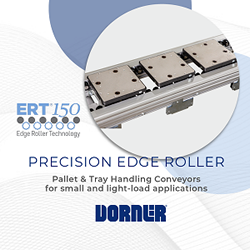Collaborative Robotics Market Value to Reach $9.7 Billion by 2025, According to Tractica
Efficiency, Quality, and Automation Gains Are Propelling the Adoption of Cobots
As the implementation of smart factories surges forward, more companies are becoming aware of the growing importance of and uses for collaborative robots (known as cobots), according to a new report from Tractica. Still, a gap exists in understanding what these robots are as well as the implications for businesses.
Large company adoption of cobots is already occurring and benefits such as lower costs, increased safety, flexibility, and personnel efficiencies are the key driving factors for cobot demand in small and medium enterprises as well. More startups are entering the industry with new user-friendly cobot offerings, making the market increasingly competitive and diverse. Even with potential barriers such as high potential costs and significant planning, deployment, and training time, Tractica forecasts that the global cobot market will continue growing rapidly over the next few years, reaching revenue of $9.7 billion by 2025.
"New opportunities are opening in the market as makers develop cobots with higher payload capacities and speed. The integration of cobots with the industrial Internet of Things (IIoT) opens new possibilities for the coordination of cobots doing smart manufacturing with the rest of the automation processes," says senior analyst Glenn Sanders. "Humanlike abilities of perception, object recognition, gripping and manipulating objects, and dual grippers present the potential to drive greater demand in the coming years."
Tractica's report, "Collaborative Robots", examines the market issues surrounding cobots and presents 8-year revenue forecasts for the industry. The report discusses the crucial market drivers, challenges, and industry applications, in addition to assessing the most important technology issues that will influence market development. Tractica profiles the top 17 industry players, organized by pure cobot vendors, industrial robot vendors, end-of-arm tooling vendors, and software framework providers. An information bank of 82 key and emerging companies is also included in this report. Market forecasts, segmented by industry, payload capacity, and application, extend through 2025. An Executive Summary of the report is available for free download on the firm's website.
About Tractica
Tractica, an Informa business, is a market intelligence firm that focuses on emerging technologies. Tractica's global market research and consulting services combine qualitative and quantitative research methodologies to provide a comprehensive view of the emerging market opportunities surrounding Artificial Intelligence, Robotics, User Interface Technologies, Advanced Computing, and Connected & Autonomous Vehicles. For more information, visit www.tractica.com or call +1.303.248.3000.
Featured Product

The ERT150 - Dorner's Next Evolution of Edge Roller Technology Conveyors
The next evolution in Dorner's Edge Roller Technology conveyor platform, the ERT®150, is ideal for small and light-load assembly automation, as well as medical and medical-device assembly application. The ERT platform is the only pallet conveyor of its kind available with an ISO Standard Class 4 rating for cleanroom applications. Earning the ISO Standard 14644-1 Class 4 rating means Dorner's ERT150 will conform and not contribute to the contamination of cleanrooms to those standards. As implied by its name, the ERT150 (Edge Roller Technology) uses rollers to move pallets through the conveyor smoothly with no friction (a byproduct often seen in belt-driven platforms). The conveyor's open design eliminates concerns of small parts or screws dropping into rollers and causing conveyor damage or jamming. The ERT150 is suited to operate in cleanroom environments requiring a pallet handling conveyor. It is capable of zoning for no or low-back pressure accumulation and is ideal for automation assembly applications within industries including medical devices, electronics, consumer goods among others.
